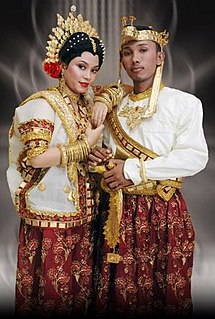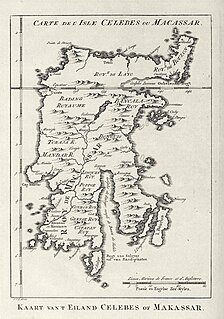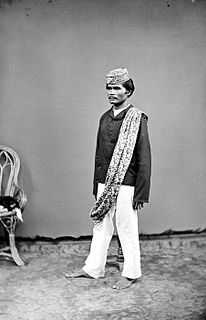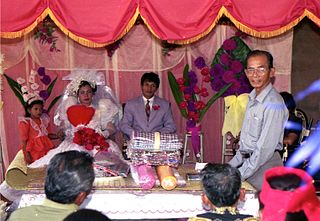
The Buginese or Bugis people are an ethnicity—the most numerous of the three major linguistic and ethnic groups of South Sulawesi, in the south-western province of Sulawesi, third largest island of Indonesia. The Bugis in 1605 converted to Islam from Animism. The main religion embraced by the Bugis is Islam, with a minority adhering to Christianity or a pre-Islamic indigenous belief called Tolotang.

Bone was a sultanate in the south-west peninsula of Sulawesi, now part of modern-day Indonesia. Covering an area of 2,600 square kilometres (1,000 sq mi), Bone's chief town Boni, lay 130 kilometres (81 mi) northeast of the city of Makassar, home to the Bugis people.

Telephone numbers in Indonesia have different systems for land lines and mobile phones: land lines use area codes, while mobile phones do not.

The Kingdom of Luwu is generally thought to be the oldest kingdom in South Sulawesi. In 1889, the Dutch Governor of Makassar placed Luwu's heyday between the 10th and 14th centuries, but offered no evidence. The La Galigo, an epic poem composed in a literary form of the Bugis language, is the likely inspiration of Braam Morris’ dating. The La Galigo depicts a vaguely defined world of coastal and riverine kingdoms whose economies are based on trade. Two early centres of this world are Luwu and the kingdom of Cina in what is now Wajo. The incompatibility of the La Galigo's trade-based political economy with the agricultural economies of other South Sulawesi kingdoms has led scholars to posit an intervening period of chaos to separate the two societies chronologically.

Wajo Regency is a regency in South Sulawesi Province of Indonesia. It covers an area of 2,506.19 km2 and had a population of 384,694 at the 2010 Census, and 379,079 at the 2020 Census. Established in 1959, Wajo Regency has its seat of government (capital) in Sengkang.

East Luwu Regency is the most easterly of the twenty-one regencies in South Sulawesi Province of Indonesia. Malili is the capital of East Luwu Regency. The population of East Luwu Regency was 243,069 at the 2010 Census and 296,741 at the 2020 Census.

Pitumpanua is a small town and kecamatan in the Wajo Regency of South Sulawesi Province, Indonesia. The town is located on the eastern coast of South Sulawesi on the Gulf of Boni. The Keera River flows through this area and into the sea.

Bone Regency is a regency of South Sulawesi, Indonesia. Originally the seat of the Bone state, it joined Indonesia in 1950. The regency covers an area of 4,559.00 km2 and had a population of 717,682 at the 2010 Census, 742,527 at the 2015 Intermediate Census and 801,775 at the2020 Census. Its main products are seaweed, rice, and fish. The principal town is Watampone, which comprises the three districts of Tanete Riattang Barat, Tanete Riattang and Tanete Riattang Timur within the regency.

Luwu Regency is a regency of South Sulawesi Province, Indonesia. The administrative capital now lies at Belopa, since the former capital (Palopo) became an independent municipality (city) in 2006, at which date the then existing Luwu Regency was split into four entities - Palopo city, North Luwu Regency, East Luwu Regency, and the residual Luwu Regency. The regency now covers 2,909.08 km2 and had a population of 287,472 at the 2010 Census and 365,608 at the 2020 Census.

North Luwu Regency is a regency of South Sulawesi Province of Indonesia. It covers 7,502.58 kim2 and had a population of 287,606 at the 2010 Census and 322,919 at the 2020 Census, comprising 163,168 males and 159,751 females. The principal town lies at Masamba.

Andi Jemma Airport, is an airport near Masamba, the capital city of North Luwu Regency in the province of South Sulawesi on the island of Sulawesi in Indonesia.
Seko Padang is an Austronesian language spoken in the North Luwu Regency of South Sulawesi, Indonesia. Together with Seko Tengah, Panasuan and Budong-Budong, it belongs to the Seko branch of the South Sulawesi subgroup.
Seko Tengah is an Austronesian language spoken in the North Luwu Regency of South Sulawesi, Indonesia. Together with Seko Padang, Panasuan and Budong-Budong, it belongs to the Seko branch of the South Sulawesi subgroup.
Lemolang is an Austronesian language of Sulawesi, Indonesia. It is spoken in two villages in North Luwu Regency, South Sulawesi.
Taeʼ is a language spoken in Tana Luwu. It is an Austronesian language of Sulawesi, Indonesia, and one of the languages of the ten tribes that inhabit Tana Luwu, South Sulawesi. The Taeʼ language is used by most of the inhabitants of the four districts of Tana Luwu: Luwu, North Luwu, Luwu Timur, and Palopo town. Taeʼ is part of the South Sulawesi group of languages. It is closely related to Toraja, and more distantly to Mandar, Massenrempulu, and Mamuju. Taeʼ is used as a lingua franca from south of the border with Buriko Kabupatan Wajo to Malili East Luwu regency, as well as in Tana Toraja and Massenrempulu.

The Makassar or Makassarese people are an ethnic group that inhabits the southern part of the South Peninsula, Sulawesi in Indonesia. They live around Makassar, the capital city of the province of South Sulawesi, as well as the Konjo highlands, the coastal areas, and the Selayar and Spermonde islands. They speak Makassarese, which is closely related to Buginese and also a Malay creole called Makassar Malay.
The South Sulawesi expeditions of 1905, which included the Third Bone War and the Gowa War, were undertaken by the Royal Netherlands East Indies Army (KNIL) to force the states of south Sulawesi (Celebes) to sign the Korte Verklaring, the standard agreement whereby a native Indonesian ruler agreed to accept Dutch sovereignty. According to certain Dutch historians, the expeditions were an "obligation", because the Dutch had responsibility for law and order. One Indonesian historian has argued that it was actually strategic: that south Sulawesi was the "key" to controlling the so-called Great East. There was also an economic motive: to extend the tax-collecting powers of the government of Sulawesi. The expeditions received the imprimatur of the Governor of Sulawesi, Alexander Kroesen, in a letter dated 11 February 1904.

Pamona people inhabits almost the entire Poso Regency, parts of Tojo Una-Una Regency and parts of North Morowali Regency, Central Sulawesi; in fact there are some even in East Luwu Regency of South Sulawesi, whereas a small remainder lives in other parts of Indonesia. The ancestors of the Pamona people originally came from the land of Salu Moge because they were once from the mountains which is far from the central governance thus they were brought down by Macoa Bawalipu of Wotu, East Luwu Regency to be nearer to the central governance, which is the surrounding region of Mangkutana. But it was until a revolt by the Darul Islam (Indonesia) rebellion broke out that they spread to Central Sulawesi and to other regions. If there are Pamona people in certain regions, then it is common that a Rukun Poso is formed there, which serves as a means of a group of people from a common ethnic background to engage in various activities within the region. Almost all of the Pamona people practices Christianity. Christianity came into the region about 100 years ago and until today it is widely accepted as the religion of the people. Today, all churches of common denomination are grouped under the Central Sulawesi Christian Church headquartered in Tentena, Poso Regency, Central Sulawesi, Indonesia. A large part of the common folk uses Pamona language and Bahasa Indonesia language that is mixed with the local slang. The Pamona people are usually farmers, government officials, pastors, entrepreneurs and so on.
Opu Daeng Risaju was an Indonesian independence activist. She was canonized as a National Hero of Indonesia in 2006.












